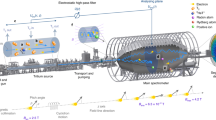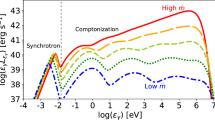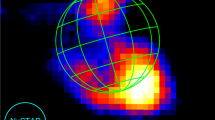Abstract
The observation1,2of neutrinos from the LMC supernova makes possible direct tests of the theory of supernova explosions and of properties of weakly interacting particles. Here we describe a combined analysis of the angular and energy distributions of the events observed in the Kamiokande and the 1MB detectors which determines the effective temperatures and fluxes of neutrinos and anti-neutrinos* produced by the explosion. Our main result is that a simple model is consistent with the available data and in reasonable agreement with conventional models of supernova explosions. The parameters of the model are: a single temperature, T, of 4.1+1.0−0.4 MeV, a flux of electron anti-neutrinos of (O.5-0.35+0.2)×1010cm−2 [total energy in v̄e = (3.0+1.7−1.4 × 1052 erg)], and a poorly determined flux of 'scattered' (see below) neutrinos = (0.2–5)× 1010 cm−2. Several statistical tests were used to determine the acceptable range of these parameters. We have also set limits on possible high-temperature fluxes of neutrinos or anti-neutrinos that might result from matter oscillations3,4
This is a preview of subscription content, access via your institution
Access options
Subscribe to this journal
Receive 51 print issues and online access
$199.00 per year
only $3.90 per issue
Buy this article
- Purchase on Springer Link
- Instant access to full article PDF
Prices may be subject to local taxes which are calculated during checkout
Similar content being viewed by others
References
1. Hirata, K. et al. Phys. Rev. Lett. 58, 1490–1493 (1987).
2. Bionata, R. M. et al. Phys. Rev. Lett. 58, 1494–1496 (1987).
3. Mikheev, S. P. & Smirnov, A. Yu. Nuovo Cimento 9C, 17–26 (1986).
4. Wolfenstein, L. Phys. Rev. D17, 2369–2374 (1978).
5. Bahcall, J., Dar, A. & Piran, A. Nature 326, 135–136 (1987).
6. Spergel, D. N., Piran, T., Loeb, A., Goodman, J. & Bahcall, J. N. Phys. Rev. Lett, (submitted).
7. Bahcall, J. Rev. mod. Phys. 59, (in the press).
8. Badino, G. et al. Nuovo dm. 7C, 573–590 (1984).
9. Bahcall, J. N. & Glashow, S. L. Nature 326, 476–477 (1987).
10. Walker, T. P. & Schramm, D. N. Phys. Lett, (in the press).
11. Baade, W. & Zwicky, F. Proc. natn. Acad. Sci. 20, 254–259 (1934).
12. Fowler, W. A. & Hoyle, F. Astrophys. J. Suppl. Ser. 9, 201–319 (1964).
13. Colgate, S. A. & White, R. H. Astrophys. J. 143, 626–681 (1966).
14. Arnett, W. D. A. Rev. Astr. Astrophys. 11, 73–94 (1973).
15. Bethe, H. A. et al. Nucl Phys. A324, 487–533 (1979).
16. Bowers, R. L. & Wilson, J. R. Astr. J. Suppl. Ser. 50, 115–160 (1982).
17. Arnett, W. D. Astrophys. J. 263, L55–L57 (1983).
18. Bethe, H. A. & Wilson, J. R. Astrophys. J. 295, 14–23 (1985).
19. Bethe, H. A. & Brown, G. Scient. Am. 252, 60–68 (1985).
20. Burrows, A. & Lattimer, J. M. Astrophys. J. 307, 178–196 (1985).
21. Wilson, J. R., Mayle, R., Woolsey, S. E. & Weaver, T. Ann. N. Y. Acad. Sci. 470, 267–293 (1986).
22. Hayano, R. S. & Ishikawa, T. Phys. Rev. Lett, (submitted).
23. Hillebrant, W. et al. Astr. Astrophys. (submitted).
Author information
Authors and Affiliations
Rights and permissions
About this article
Cite this article
Bahcall, J., Piran, T., Press, W. et al. Neutrino temperatures and fluxes from the LMC supernova. Nature 327, 682–685 (1987). https://doi.org/10.1038/327682a0
Received:
Accepted:
Issue Date:
DOI: https://doi.org/10.1038/327682a0
This article is cited by
-
Did Popper solve Hume's problem?
Nature (1993)
-
A way to limit selectron mass using supernova neutrino data
Il Nuovo Cimento A (1992)
-
Pulsar magnetic moment decay due to radiation damping and the pulsar in SN 1987 A
Il Nuovo Cimento C (1989)
-
Geochemical integrations of the neutrino flux from stellar collapses
Nature (1988)
Comments
By submitting a comment you agree to abide by our Terms and Community Guidelines. If you find something abusive or that does not comply with our terms or guidelines please flag it as inappropriate.



